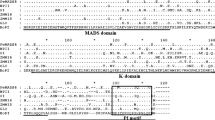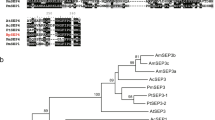Abstract
Three highly identical cDNA clones of APETALA3 (AP3) gene, BnAP3-2, BnAP3-3 and BnAP3-4 were isolated from Brassica napus L. by RT-PCR. The sequence analysis showed that all the three AP3 cDNAs contained a complete open reading frame. Their nucleotide sequences had 91–97 % similarity and their predicted amino acid sequences shared 93–98 % identity. Real-time quantitative RT-PCR result showed that all the three BnAP3 genes were expressed at the transcriptional level in petals as well as stamens. Among the three BnAP3 genes, BnAP3-3 was expressed at the highest level and BnAP3-2 was expressed at the lowest level in petals. The transcription level of BnAP3-3 was 1.59 times than that of BnAP3-2. The transcription levels of BnAP3-2, BnAP3-3 and BnAP3-4 in stamen were 7.75, 5.11 and 3.88 times than those in petal, respectively. The yeast two-hybrid assays results showed that all the three BnAP3 proteins could form strong heterodimers with BnPI, and obviously different dimerization affinities among the three proteins to BnPI were observed. The ratio of the affinity of BnAP3-2, BnAP3-3 and BnAP3-4 to BnPI-1 was 1.27:1:1.62. Although the three BnAP3 genes were highly identical, the differences of their expression and affinity of protein interaction might reflect some functional divergence.
Similar content being viewed by others
Abbreviations
- AP3:
-
APETALA3
- PCR:
-
polymerase chain reaction
- PI:
-
PISTILLATA
- RT:
-
reverse transcription
Reference
Blanc, G., Wolfe, K.H.: Widespread paleopolyploidy in model plant species inferred from age distributions of duplicate genes. — Plant Cell 16: 1667–1678, 2004.
Bodt, S., Maere, S., Peer, Y.V.: Genome duplication and the origin of angiosperms. — Trends Ecol. Evol. 20: 591–597, 2005.
Bowman, J.L., Smyth, D.R., Meyerowitz, E.M.: Genes directing flower development in Arabidopsis. — Plant Cell 1: 37–52, 1989.
Bowman, J.L., Smyth, D.R., Meyerowitz, E.M.: Genetic interactions among floral homeotic genes of Arabidopsis. — Development 112: 1–20, 1991.
Cui, L., Wall, P.K., Leebens-Mack, J.H., Lindsay, B.G., Soltis, D.E., Doyle, J.J., Soltis, P.S., Carlson, J.E., Arumuganathan, K., Barakat, A., Albert, V.A., Ma, H., De Pamphilis, C.W.: Widespread genome duplications throughout the history of flowering plants. — Genome Res. 16: 738–749, 2006.
Duarte, J.M., Cui, L., Wall, P.K., Zhang, Q., Zhang, X., Leebens-Mack, J., Ma, H., Altman, N., De Pamphilis, C.W.: Expression pattern shifts following duplication indicative of subfunctionalization and neofunctionalization in regulatory genes of Arabidopsis. — Mol. Biol. Evol. 23: 469–478, 2006.
Force, A., Lynch, M., Pickett, F.B., Amores, A., Yan, Y.L., Postlethwait, J.: Preservation of duplicate genes by complementary, degenerative mutations. — Genetics 151: 1531–1545, 1999.
Goto, K., Meyerowitz, E.M.: Function and regulation of the Arabidopsis floral homeotic gene PISTILLATA. — Genes Dev. 8: 1548–1560, 1994.
Honma, T., Goto, K.: The Arabidopsis floral homeotic gene PISTILLATA is regulated by discrete cis-elements responsive to induction and maintenance signals. — Development 127: 2021–2030, 2000.
Irish, V.F., Litt, A.: Flower development and evolution: gene duplication, diversification and redeployment. — Curr. Opin. Genet. Dev. 15: 454–460, 2005.
Jack, T.: Relearning our ABCs: new twists on an old model. — Trends Plant Sci. 6: 310–316, 2001.
Jack, T., Brockman, L.L., Meyerowitz, E.M.: The homeotic gene APETALA3 of Arabidopsis thaliana encodes a MADS box and is expressed in petals and stamens. — Cell 68: 683–697, 1992.
Jack, T., Fox, G.L., Meyerowitz, E.M.: Arabidopsis homeotic gene APETALA3 ectopic expression: transcriptional and posttranscriptional regulation determine floral organ identity. — Cell 76: 703–716, 1994.
Kramer, E.M., Dorit, R.L., Irish, V.F.: Molecular evolution of genes controlling petal and stamen development: duplication and divergence within the APETALA3 and PISTILLATA MADS-box gene lineages. — Genetics 149: 765–783, 1998.
Kramer, E.M., Holappa, L., Gould, B., Jaramillo, M.A., Setnikov, D., Santiago, P.M.: Elaboration of B gene function to include the identity of novel floral organs in the lower eudicot Aquilegia. — Plant Cell 19: 750–766, 2007.
Kramer, E.M., Irish, V.F.: Evolution of the petal and stamen developmental programs: evidence from comparative studies of the lower eudicots and basal angiosperms. — Int. J. Plant Sci. 16: 29–30, 2000.
Krizek, B.A., Fletcher, J.C.: Molecular mechanisms of flower development: an armchair guide. — Nature 42: 688–698, 2005.
Krizek, B.A., Meyerowitz, E.M.: The Arabidopsis homeotic genes APETALA3 and PISTILLATA are sufficient to provide the B class organ identity function. — Development 122: 11–22, 1996.
Lamb, R.S., Irish, V.F.L.: Functional divergence within the APETALA3/PISTILLATA floral homeotic gene lineages. — Proc. nat. Acad. Sci. USA 100: 6558–6563, 2003.
Lewis, E.B.: Pseudoallelism and gene evolution. — Cold Spring Harb. Symp Quant. Biol. 16: 159–174, 1951.
Lynch, M., Conery, J.S.: The evolutionary fate and consequences of duplicate genes. — Science 290: 1151–1155, 2000.
McGonigle, B., Bouhideland, K., Irish, V.F.: Nuclear localization of the Arabidopsis APETALA3 and PISTILLATA homeotic gene products depends on their simultaneous expression. — Genes Dev. 10: 1812–1821, 1996.
Nagahara, U.: Genome analysis in Brassica with special reference to the experimental formation of B. napus and peculiar mode of fertilisation. — J. jap. Bot. 7: 389–452, 1935.
Ohno, S.: Evolution by Gene Duplication. — Springer-Verlag, Berlin - New York 1970.
Palmer, J.D., Shields, C.R., Cohen, D.B., Orton, T.J.: Chloroplast DNA evolution and the origin of amphidiploid Brassica species. — Theor. appl. Genet. 65: 181–189, 1983.
Parkin, I.A.P., Sharpe, A.G., Keith, D.J., Lydiate, D.J.: Identification of the A and C genomes of the amphidiploid Brassica napus (oilseed rape). — Genome 38: 1122–1131, 1995.
Pylatuik, J.D., Lindsay, D.L., Davis, A.R., Bonham-Smith, P.C.: Isolation and characterization of a Brassica napus cDNA corresponding to a B-class floral development gene. — J. exp. Bot. 54: 2385–2387, 2003.
Riechmann, J.L., Krizek, B.A., Meyerowitz, E.M.: Dimerization specificity of Arabidopsis MADS domain homeotic proteins APETALA1, APETALA3, PISTILLATA, and AGAMOUS. — Proc. nat. Acad. Sci. USA 93: 4793–4798, 1996b.
Riechmann, J.L., Wang, M., Meyerowitz, E.M.: DNA-binding properties of Arabidopsis MADS domain homeotic proteins APETALA1, APETALA3, PISTILLATA and AGAMOUS. — Nucl. Acids Res. 24: 3134–3141, 1996a.
Schmidt, R., Acarkan, A., Boivin, K.: Comparative structural genomics in the Brassicaceae family. — Plant Physiol. Biochem. 39: 253–262, 2001.
Vandenbussche, M., Zethof, J., Royaert, S., Weterings, K., Gerats, T.: The duplicated B-class heterodimer model: whorl specific effects and complex genetic interactions in Petunia hybrida flower development. — Plant Cell 16: 741–754, 2004.
Wagner, A.: The fate of duplicated genes: loss or new function? — Bioessays 20: 785–788, 1998.
Yadav, S.R., Prasad, K., Vijayraghavan, U.: Divergent regulatory OsMADS2 functions control size, shape and differentiation of the highly derived rice floret second whorl organ. — Genetics 176: 283–294, 2007.
Yang, Y., Fanning, L., Jack, T.: The K domain mediates heterodimerization of the Arabidopsis floral organ identity proteins, APETALA3 and PISTILLATA. — Plant J. 33: 47–59, 2003.
Zachgo, S., Andrade, S.E., Motte, P., Trobner, W., Saedler, H., Schwarz-Sommer, Z.: Functional analysis of the Antirrhinum floral homeotic deficiens gene in vivo and in vitro by using a temperature-sensitive mutant. — Development 121: 2861–2875, 1995.
Zhao, Y., Wang, M.L.: Inheritance and agronomic performance of an apetalous flower mutant in Brassica napus L. — Euphytica 137: 381–386, 2004.
Acknowledgements
We thank Prof. Q.S. Liu for reviewing the manuscript. This work was supported by the National Natural Science Foundation of China (Grant Nos. 30571174 and 30871540). The first two authors participated equally on the paper.
Author information
Authors and Affiliations
Corresponding author
Rights and permissions
About this article
Cite this article
Zhou, L., Zhou, Y.T., Wang, M.L. et al. Expressions and dimerization affinities of three highly identical APETALA3 genes in Brassica napus . Biol Plant 54, 33–40 (2010). https://doi.org/10.1007/s10535-010-0005-3
Received:
Accepted:
Published:
Issue Date:
DOI: https://doi.org/10.1007/s10535-010-0005-3




